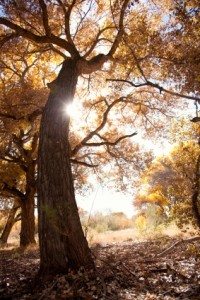
The two most common types of Cottonwoods that live in Colorado are the Narrowleaf Cottonwood and the Plains Cottonwood. Cottonwoods are part of the Poplar family and in maturity are large, dense, beautiful giants that tower over our other smaller, common varieties of trees in Colorado.
These regal trees hold much of Colorado’s history and if you have one in your yard, I am sure it holds your family’s history as well. Many tree houses and tire swings have called the Cottonwood home, so caring for these trees properly will improve the trees longevity and keep your tire swing a-swingin’ for your children and their children’s children.
Hiring an ISA certified arborist for tree service involving tree trimming is always the recommended route. Proper pruning techniques will promote healthy structural growth, and vigor for the tree.
All trees especially large species benefit from periodic pruning which prolongs the tree’s lifespan. Besides prolonging the tree’s lifespan, removing the deadwood from a tree will assist the tree in being less prone to diseases.
For example, Cottonwoods are prone to a disease called Cytospora Canker, which attacks vulnerable trees and enters the tree through wounds from storm damage and deadwood. Cytospora Canker just sounds infectious, anything involving a canker has got to be bad, and it is. Cytospora canker is a fungal disease and the disease pathogens are spread through rain, wind, animals and insects. The canker develops and girdles the branches and eventually kills the tree.
By keeping your tree free from deadwood you can prevent your tree from infection. Cottonwoods are not the only trees that suffer from this disease, and being highly contagious it is common to see the disease spread to other neighboring trees. Trimming your Cottonwood will eliminate dead, dying and diseased branches, as well as crossing and interfering weak branches, allowing for more light and air movement through the foliage which also prevents disease.
With the extreme weather we have in Colorado it is normal to be worried about breakage and damage to structures and people when you have a very large Cottonwood in your yard. This worry may lead you to believe that trying to minimize the tree’s size may help the tree “weather the storm.” Any professional arborist will tell you, topping your Cottonwood tree is not a good idea and is a practice that is not promoted and is frowned upon in arboriculture.
Topping your Cottonwood to protect the large upper branches from breaking is actually going to cause the tree to produce sucker growth where the tree was topped. Sucker growth is a sure sign of a stressed tree, these fast growing shoots are very weak and will break from snow or wind and usually decay causing wood to rot. Topping creates disfigured trees that are more susceptible to insect and disease infestation. A topped Cottonwood will never regain it’s natural branching structure and will be unsightly besides being unhealthy.
Please believe your arborist when he tells you, “You just can’t make a big tree small.”
Your Cottonwood is big and beautiful, and deserves the best tree care possible. Boulder’s notable tree tour includes a Cottonwood on the university campus that was planted in 1876, this tree is 136 years old, and thanks to proper pruning techniques, and some tender loving care from a qualified arborist, you can start giving thanks to trees and it will continue to thrive for many more years.



